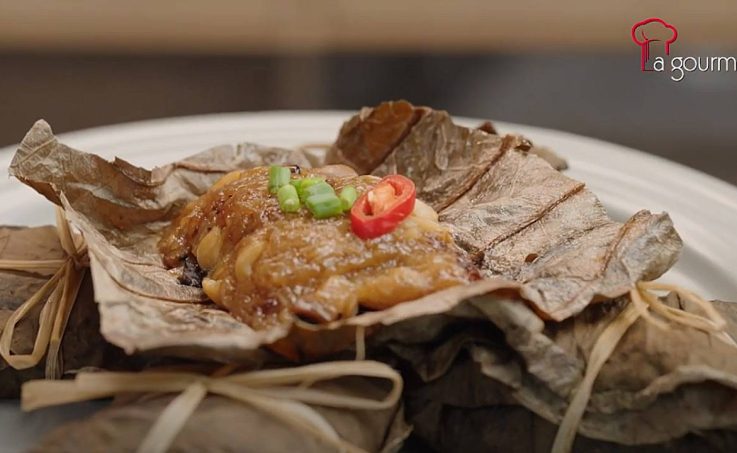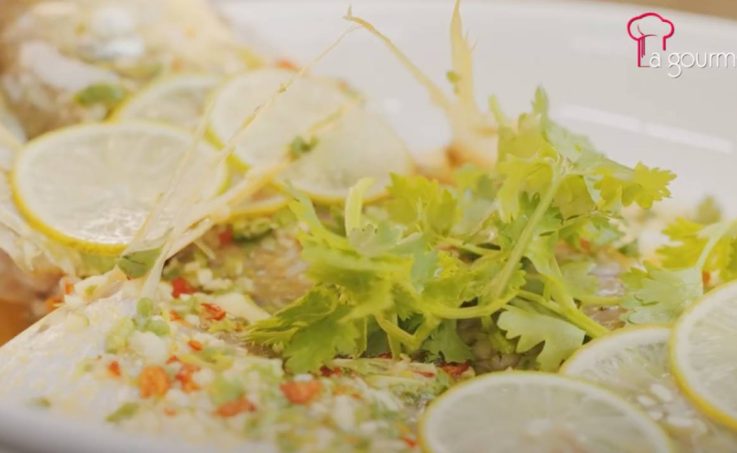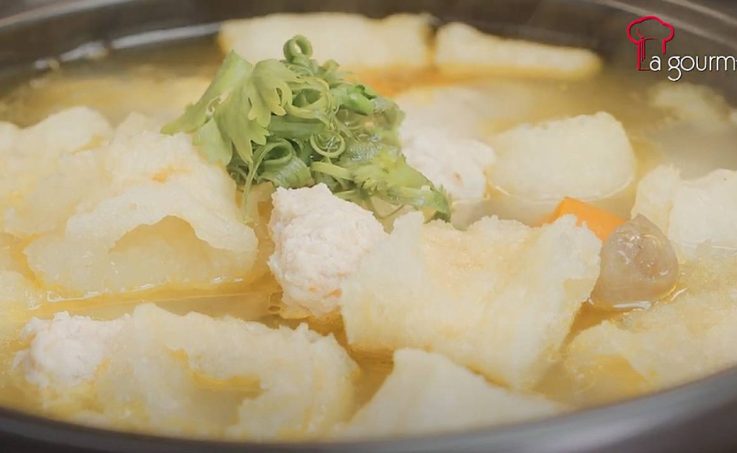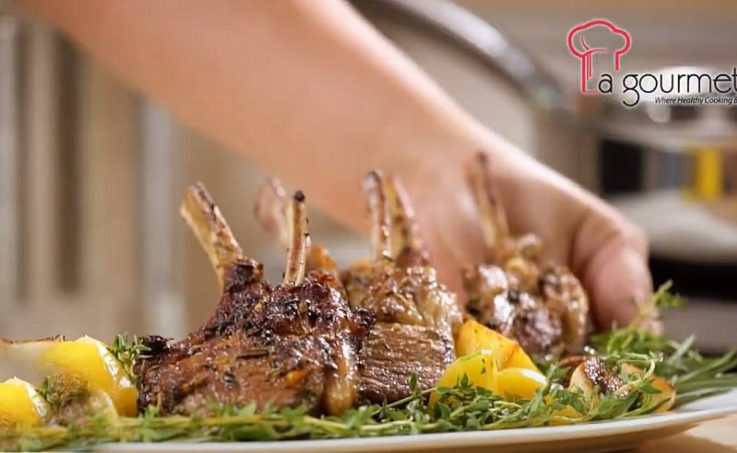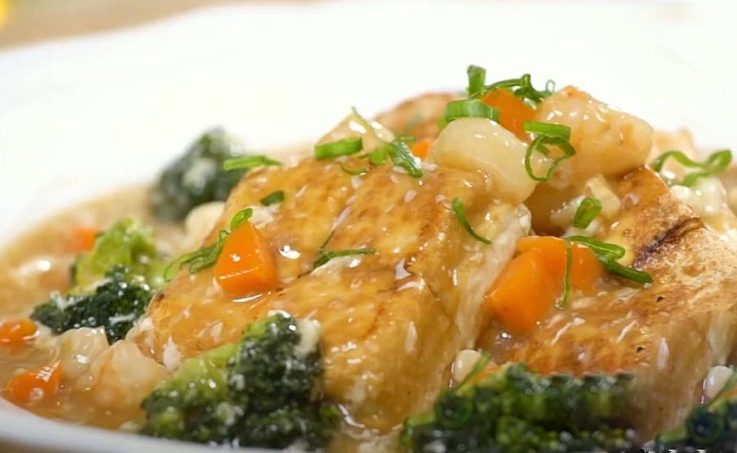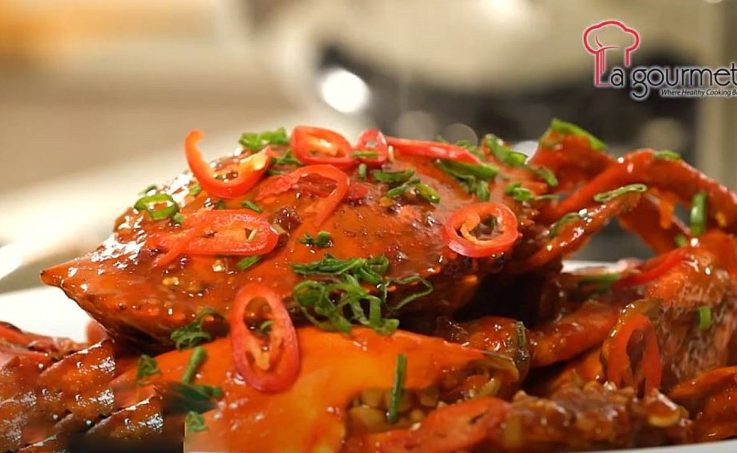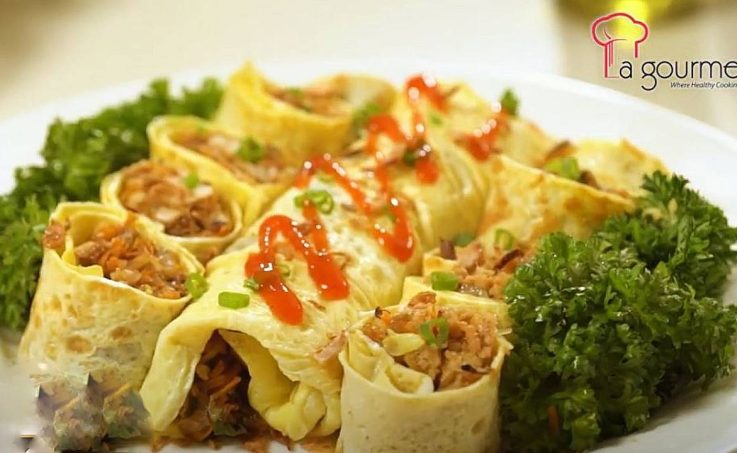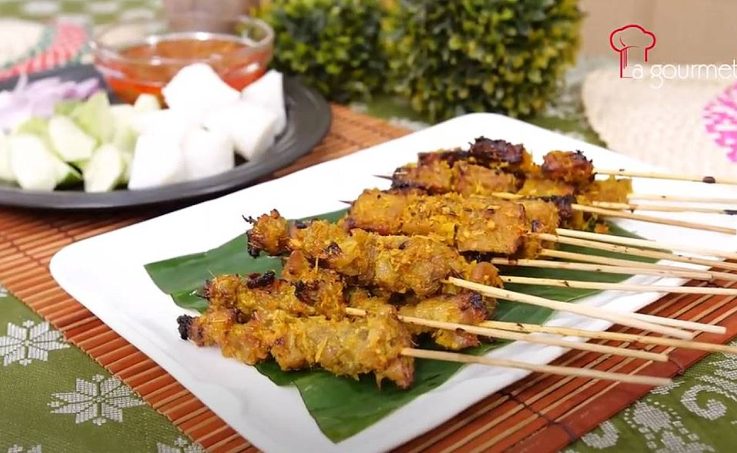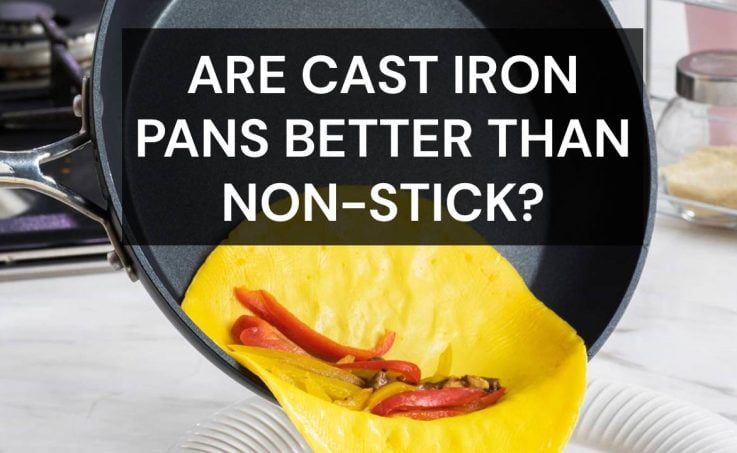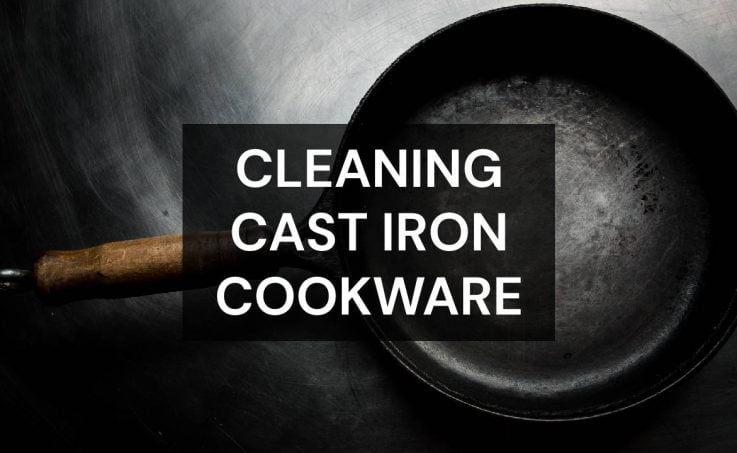Best Glutinous Rice Wraps or Lo Mai Kai Recipe
This mouth-watering glutinous rice or lo mai kai will require quite some time to make. On the bright side, you can make a huge bunch of these wraps, steam them, and freeze them for some other time. Another tip: you don’t really need to utilize lotus leaves.
In the event that you can get them, most certainly use them. They add an intriguing flavour to the rice as it steams. In any case, we found that parchment paper additionally functions admirably for this.
Here’s how to make this glutinous rice wraps or lo mai kai:
Ingredients for this lo mai kai:
- dried hemp string
- dried lotus leaves
- 3 cups of glutinous rice
- 30 pcs dried lotus seeds
- 30 g dried oysters
- 5 dried shiitake mushroom
- 35 g dried prawns
- 3 cups water
- 1 tbsp sesame oil
- 3 tbsp oyster sauce
- 2 tbsp canola oil
- 1 tbsp dark soy sauce
- 2 tbsp light soy sauce
- 1 tsp pepper
- 1 tsp salt
- 1 tsp sugar
- 1 tsp chicken stock powder
Instructions to make lo mai kai:
- Fry the dried oyster and mushroom with the open-lid cooking function of the La gourmet pressure cooker.
- Put in the lotus seed, oyster sauce, light soy sauce, dark soy sauce, rice, chicken stock, sugar, salt, and pepper.
- Add in 3 cups of water. Stir. Let it cook for 12 minutes as set by the pressure cooker. This may differ from another brand of pressure cooker. La gourmet pressure cooker has fuzzy logic that automatically adjusts pressure and temperature.
- Wrap the cooked rice into the lotus leaf. Lo mai kai just wouldn’t be something similar without the lotus leaf. Besides the fact that it keeps it all intact, however, it adds that unobtrusive scent to the dish.
Lotus leaves are normally sold at Asian general stores or the wet market, and they should be soaked in water for an hour prior to being utilized to wrap up the rice. In the event that you don’t can’t observe lotus leaves, you actually can make this recipe utilizing parchment paper. Note that this won’t give it the traditional glutinous rice taste.
You can serve your glutinous rice wraps with a little bean stew oil or permit them to cool, place into cooler packs, and keep them up for some other time! At the point when you’re prepared to eat them, simply steam them right out of the cooler for around 30 minutes.
Lo mai kai are best when they are hot and right out of the liner. To eat, eliminate the string that is maintaining a level of control and cautiously open up the lotus leaf. They can likewise be eaten later in the day, and simply should be steamed, and they freeze well.
How to prepare the lotus leaves?
Here are the means to prepare the dried lotus leaves:
In the first place, fill an enormous bowl or any compartment sufficiently huge to fit the leaves with water.
Then, at that point, drench the dried lotus leaves until they rehydrate completely. It will require essentially 60 minutes.
From that point forward, heat a huge pot of water to the point of boiling. Blanch the leaves for five minutes or somewhat longer until they are softened completely. The leaves might break when you use them to wrap the rice on the off chance that they are still solid and unbending.
Eliminate them from the water, then clean them with a sodden material to clean it off any soil.
Cut back the abundance whenever required. I favour managing the leaves as per the size required prior to drenching and whitening them. This progression is useful in light of the fact that I don’t have an enormous holder to fit the untrimmed leaves.
Here is how to wrap your lo mai kai in lotus leaf:
Cut back the overabundance of the leaf prior to wrapping. The leaves are too large for one part except if you intend to make an enormous Lotus Leaf Rice wraps shared by a couple of individuals.
Place the leaf with the tip of the stem pointing down in a shallow bowl.
Arrange the lo mai kai at the base most piece of the leaf bundle. You can put the extra ingredients on the top as well. This is so that it remains on top considering that it will be turned overturned while serving.
Add the seared rice into the leaf and press to marginally pack it.
Overlap the leaf inwards like shutting an envelope.
Switch the wrap so the tip of the stem is confronting vertically.
Put the lo mai kai on a plate or liner crate, cover it if conceivable to stay away from water buildup from dropping onto the rice parcel while steaming.
Steam for twenty minutes over medium hotness.
Take out the lo mai gai from the steamer. Remove the highest point of the leaf to uncover the rice, then, at that point, embellish it with daintily cut scallion and red bean stew to serve.
Note: The motivation behind steaming the rice isn’t to cook it since it is as of now pan-seared. Steaming is intended to aroma the rice with the flavour and fragrance of the leaf. The fragrance of the lotus leaf will get more grounded assuming you steam it longer. It requires something like twenty minutes of steaming to get the rice imbued with lotus leaf smell and flavour.
The following are four methods for making this glutinous rice dish better for health.
- With a slight bend from the standard thing, add butternut squash shapes (or pumpkin) into the dish to add a characteristic touch of pleasantness to the appetizing flavours while additionally lighting up the dish for certain tones. Besides being a complex carb that can assist you with feeling more full while eating less rice, squash and pumpkin are loaded with nutrition and a natural source of antioxidants for better health.
- Low sodium chicken stock is utilized in this recipe to restrict the sodium consumption, decreasing the risk of hypertension and other medical conditions. Assuming you have additional time, you can make your own chicken stock by boiling chicken bones with water and a huge touch of salt.
- We can use chicken filets as a better yet rich wellspring of protein. To defeat the tacky surface of overcooked chicken bosoms, we added some corn flour to the chicken and diminished the cooking time.
- Glutinous rice has a chewier and starchier surface when contrasted with customary long-grain rice. With a normally better flavour profile, it gives a flavorful taste and nicer texture. Nonetheless, it is the most noteworthy the glycaemic file among all the rice types accessible on the lookout.
Hope these tips will help you craft the best lo mai kai!
For fantastic cookware deals, swing by our website!
Thai Steam Fish – An Auspicious & Healthy Dish
Thai Steam Fish – An Auspicious & Healthy Dish
Thai steam fish is a popular, straightforward dish frequently filled in as one of the last courses in a Chinese wedding dinner or during Chinese New Year for auspicious reasons.
Likewise, a dish can be found on home dinner tables on any old weeknight. That is the way you know it’s not simply simple… it’s truly delectable.
All you want is a couple of straightforward ingredients that can most likely currently be found in your own kitchen top and fridge.
You’ll get the hang of it rapidly as well. It’s a simple and flavorful method for preparing fish. Your family will love it! Here’s how to make this Thai steam fish recipe:
Ingredient
- 800g Grouper (gutted and cleaned)
Ingredients A
- 4 stalks Coriander Roots
- 4 – 5 Bird’s Eye Chillies
- 10 Cloves Garlic
Sauce B
- 7 – 8 tbsp. Fish Sauce
- 1 tsp. Chicken Powder
- 5 Limes (juice extracted)
- 3 – 4 tbsp. Sugar
Directions to make this Thai steam fish:
- Using the La gourmet Healthy glass food chopper, roughly chop ingredients A together.
- Next, mix the chopped concoction with the sauce B ingredients then set aside.
- Heat Elite wok with enough water, and bring to a rapid boil.
- Place the cleaned fish on a plate, put it on the steaming rack and steam the fish for 8 – 10 mins.
- Remove fish from the steamer, discard the steamed liquid, leaving only the fish on the plate and pour the combined lime chilli sauce.
- Garnish the Thai steam fish with extra coriander leaves.
What is the right fish that is perfect for steaming?
The Chinese love to steam entire fish, particularly the more seasoned age of people who consider the fish head and stomach the most awesome delicacies! In any case, getting ready, cooking, and serving entire fish has its difficulties, so many pick the more straightforward filet choice.
Picking the kind of fish filet to cook clearly relies upon accessibility and freshness, yet pretty much any common white fish is a decent decision.
Stay away from slick and firm fish like bluefish, mackerel or swordfish. Here’s a list of fish that is perfect to be used for this recipe:
- Fumble or accident
- Ocean bass
- Haddock
- Sea roost
- Grouper
- Cod
- Freshwater tilapia
How do I tell when my steamed fish is cooked?
Many sorts of fish are tender and delicate, so you need to try not to overcook them. The most effective way to let know if your fish is done is by trying it with a fork at a slanted angle, at the thickest point, and twist gently. The fish will come off effectively when it’s done and it will lose its clear or crude appearance.
How long do you need to steam the perfect fish?
Steaming fish can be done quite quickly particularly with the fish filets we’re utilizing in this recipe.
Likewise with any protein, bones expand cooking times, so it very well may be a piece trickier to decide when your fish is finished.
Indeed, even with fish filets, however, steaming time will in any case differ in view of the kind, size, and thickness of your filet.
For little, slender filets, your fish might cook in as brief period as 4-5 minutes. Thicker, bigger fillets will take more time.
It’s ideal to check the fish prior and continue to steam for an extra 1-2 minutes if necessary. Try not to overcook the fish, as it can get slightly hard or rubbery! Which is not a good sensation for eating.
How would you soften a hard fleshed fish?
The utilization of buttermilk is a compelling and delectable method for softening fish, which is hard to soften in any case by beating it with a mallet. The acids establishes in the buttermilk will separate the fish, making the completed item more delicate and delectable.
Is steamed fish a healthier option?
Thai steam fish is a low calorie protein recipe that fills the tummy for longer time without adding high fat substance. Steaming the fish assists it with holding its nutrients and minerals that you can lose while frying or grilling. It is additionally loaded with omega 3 unsaturated fats which radically helps with cardiovascular wellbeing.
For what reason is my fish flesh texture tough and rubbery?
Fish is quite possibly the most troublesome protein to cook. Whenever cooked excessively over long periods of time, it gets extreme and chewy quick. Regardless of whether sautéed appropriately, you may not yield the right surface because of it having been frozen.
What fish is typically used in Thai cooking?
In Thailand, small whole fish is utilized for their famous Thai steamed fish, so you might need to pick either a couple of rainbow trout (one for each individual) or an entire snapper. When the fish is cooked, it is dressed with a heavenly sauce of tamarind glue, garlic, galangal, coriander, fish sauce, and red bean stews.
How to steam the fish when you don’t have a steamer?
Steam In Water
To steam in water, fill a pot with 1/2 inch of water, add the fish or vegetables, cover, heat to the point of boiling, and cook until fresh delicate. Drain the water and put aside. This method functioned admirably for the broccoli, and would likewise be really great for other firm vegetables like cauliflower or carrots, yet the potatoes wound up tasting watery. What’s more, contrasted with different tests, it wasn’t the simplest or quickest choice.
Steam with Plate On Tinfoil
To steam your fish, simply fill a medium pot with 1/2 inch of water, place three golf ball-sized bundles of aluminum foil on the base, rest a hotness resistant plate on top of the foil balls, cover the pot, and heat the water to the point of boiling. Add fish and vegetables to the plate, cover, and steam until fresh delicate. Cautiously transfer the food from the plate and put away. The aluminum-foil-and-plate combo fundamentally turns into a DIY steamer that lifts the plate up above the water. This strategy is really basic and a nice alternative.
Check out our website for stunning cookware deals!
Fish Maw Soup – This Recipe Is Good For The Skin!
Fish Maw Soup – This Recipe Is Good For The Skin!
Fish maw is essentially dried fish bladder. However, try not to let that put you off! Fish maw or otherwise called hu pioh in Hokkien language, is an air bladder from huge fishes that adds to the capacity of a fish to drift in the water. In a few Asian societies, Fish maw is viewed as a food delicacy in light of its costly price. It is normally served braised, stewed or in soup. You can really purchase Fish Maw in dried or seared structure. The dried structure is well, hard and dry, though the broiled structure is all puffy and exceptionally light. Assuming you purchase the dried Fish Maw, you should drench them any more time until they are delicate
Growing up, Fish Maw Soup was a well-known sacred food for wonderfully energetic skin. Fish maw is known to be astoundingly rich in collagen, which assists with keeping the skin’s appearance brilliantly smooth. It’s likewise said to help with blood flow when consumed.
Fish maw doesn’t have a lot of taste of its own (somewhat boring as a matter of fact) and subsequently, it ingests the kinds of the fluid it is cooked in well indeed. To make any fish maw soup, all you really want is a decent stock and you’re set. Contingent upon the fixings you use, it tends to be straightforward and unattractive or extravagant.
Ingredients A
- 50g Dried Fish Maw
Ingredient B (Prawn Meat Balls)
- 80g Chicken Fillet Meat
- 80g shelled Prawns
- ½ tsp Pepper
- ½ tsp Chicken Stock powder
- ¼ tsp Caster Sugar
- ½ tsp Sesame Oil
- 1 tbsp Corn Flour
Ingredients C
- 1L Chicken Broth (Heinz)
- 5 – 6 pieces White Peppercorn (crushed)
- 5 Water Chestnuts (peeled and halved)
- 5 pieces canned Straw Mushroom (drained and halved)
Garnishing
- Some chopped spring onion and coriander
Directions to make this fish maw soup:
- Soak fried fish maw until softened, then blanch in boiling water briefly. Drain and set aside.
- Using the La gourmet Food Chopper, mince ingredients A. Dish out and make it into a ball. Set aside.
- Bring 1L water and chicken broth to a simmering in La gourmet Truly Oriental Claypot. Add in peppercorn and add water chestnuts (using inner pot thermal cooker).
- Drop-in prawn meatballs and cook until they float.
- Add in prepared fish maw and straw mushrooms. Bring to a simmering boil.
- Serve the fish maw soup with garnishing.
How do get ready fish maw prior to cooking it in the soup?
The fish maw needs to be soaked prior to cooking. The drenching time will shift contingent upon the kind of fish maw.
Premium fish maw:
– Soak fish maw in water for 12-18 hours until it softens up.
– Change the water occasionally and flush with cool water to get rid of its off-putting smell.
– Put ginger and shallot into a pot of new water and boil. Switch off the hotness after the water is boiled.
– Put the splashed fish maw into the pot and firmly covered with the top. Hold on until the water chills off.
– Take out the fish maw and wash with clean water then it is presently prepared for cooking.
– Soaked fish maw ought to be put away in the fridge at under 0℃ on the off chance that not cooked. Defrost each time prior to serving.
Fish maw tubes :
– Absorb fish maw new water for 6-12 hours until it relaxes.
– Change the water every once in a while and wash with cool water to take out its off-putting smell.
– Put ginger and shallot into a pot of new water and boil. Switch off the hotness after the water is boiled.
– Put the drenched fish maw into the pot and firmly covered with the top. Hold on until the water chills off.
– Take out the fish maw and wash with clean water then it is presently prepared for cooking.
– Drenched fish maw ought to be put away in the fridge at under 0℃ in the event that not cooked. Defrost each time prior to serving.
Why fish maw turns out to be meagre and gel subsequent to cooking?
Fish maw contains rich gel content which can effectively get liquefied in the event that the cooking time is too lengthy and the hotness is excessively solid. We ought to focus on the control of drenching and cooking time and the hotness temperatures. Abstain from involving high temp water for dousing or cooking with solid hotness to abbreviate the handling time. This will prompt the loss of fish maw’s gel content.
Is more seasoned fish maw or fish maw having delayed openness to sunlight is of higher quality?
There is a truism that the more established the fish maw, the better the quality. Truth be told, the length of capacity doesn’t influence the remedial worth of fish maw. Nonetheless, assuming the fish maw has been put away for quite a while and presented for a long time in daylight, its surface will become stiffer and its brilliant yellow variety turns hazier, which makes it look more interesting to the client. In addition, its totally dry body can give greater expandability subsequent to splashing.
How do you choose fish maw?
A decent quality fish maw ought to be thick yet looks clear when light sparkles through and doesn’t deteriorate into anything while at the same time cooking, it ought to be delicate and elusive. Fish maw from male fish can endure long bubbling times better while females become delicate and thick much faster. Dried fish maw is more grounded than the southern style kind and better for cooking feeding soups. The fish maw is not difficult to reconstitute, assimilates sauce effectively and gives an elastic surface to dishes.
Is fish maw healthy?
Fish maw is a decent wellspring of collagen, which is essential in solid skin excellence in all age gathering of one or the other orientation, for pregnant ladies, the skin of their infants. Collagen is equipped for saving fine composition and improving blood circulation.
Give this fish maw soup recipe a try and let us know how it goes.
Don’t forget to check out our website for irresistable promos!
Tastiest Grilled Lamb Short Ribs using Honeycomb Wok
Tastiest Grilled lamb short ribs using Honeycomb Wok
Spring is most certainly the season for grilled lamb. If you’re like most people, you probably have an assumption that lamb has an excessively gamey flavour that is unpleasant for most. That’s what the actual truth is assuming the vast majority had a sample of a good, appropriately cooked grilled lamb, they would have changed their mind. I was one of those individuals that swore I wouldn’t generally care for grilled lamb until I had the most scrumptious, delicate and impeccably prepared grilled lamb in this recipe.
The significant thing about grilled lamb is that you need to know what ingredients boost its extraordinary flavour. Lamb is phenomenal when prepared with garlic, rosemary, thyme, oregano, exquisite, lemon, fennel, mustard and mint, just to give some examples. Assuming that you’re working with one or more of these flavours, you’re most certainly headed in the correct direction for an awesome meal.
Here’s how to make this fantastic grilled lamb dish:
Ingredients:
- 2 large garlic cloves (crushed)
- 1 tbsp fresh rosemary leaves
- 1 tbsp fresh thyme leaves
- Pinch cayenne pepper
- Coarse sea salt
- 2 tablespoons extra-virgin olive oil
- 6 lamb chops (about ¾ inch thick)
Steps:
- Add the garlic, rosemary, thyme, cayenne, and salt into La gourmet electric chopper and mix well.
- Pour the olive oil into the glass food chopper and pulse it into a paste.
- Rub the paste on both sides of the lamb chops and let them marinate for at least 1 hour in the fridge. If you can prepare this the night before, it’ll be better!
- Heat up the frying pan over high heat until it reaches the smoke point. Then, lower the flame to medium, add the lamb chops and sear for about 2 minutes.
Each cooking fat, be it margarine, fat, or oil, has a smoke point: a temperature at which it quits shining and starts conveying obvious smoke signals. Figuring out how to decipher those signs is an essential component of any great cook’s jargon.
- Flip the chops over and cook for another 3 minutes for medium-rare and 3 ½ minutes for medium. Transfer to a plate.
- Decorate with potatoes and greens. Serve while it’s hot.
What amount of time does it require to cook grilled lamb?
Assuming that you like your grilled lamb cooked to medium-interesting (as I do), you’ll barbecue them sufficiently long to get a decent burn outwardly and remain delicious inside. Barbecuing for 3 to 4 minutes for each side over medium-high hotness on a charcoal or gas bar-b-que is perfect. To check for the right inner temperature, a moment read thermometer or meat thermometer ought to peruse 58°C when embedded in the thickest part. Allow the grilled lamb to rest 5 minutes prior to serving.
Since all lamb chops are of various sizes, it is recommended that utilizing a thermometer is the most ideal way to get your lamb chop cooked to the temperature you like. 43°C for rare, 54°C for medium-rare and 65°C for medium.
What is the best seasoning to enhance the grilled lamb’s flavour?
Grilled lambs are so heavenly on their own that they don’t need long marinating times or even a lot of preparing, simply olive oil, salt and pepper will do. However, I suggest adding garlic and rosemary too for the manner in which they highlight the kind of sheep. Other new spices like Fresh thyme as well as oregano would likewise be flavorful! In the event that you like to add an explosion of newness not long prior to serving, a press of fresh lemon juice is one thing you can add as a cherry on top.
How to reduce the gamey smell of the lamb?
One incredible method for diminishing the gamey lamb smell is to veil it with flavours. Contingent upon your dish, you can utilize sweet or appetizing spices and flavours. Cinnamon, allspice, ginger and cloves are great decisions for sweet dishes. Use spices like rosemary, savvy, dark pepper and time for flavorful dishes. Garlic has a solid fragrance, while a hint of acidic lemon juice, frequently used to battle the smell of fish, can lessen the smell in sheep.
Utilizing a marinade, for example, teriyaki or a mix of soy, ginger and pineapple, will add some steam during the cooking system, yet will lessen the gamey flavour and fragrance. Lamb meat can be marinated for as long as five days prior to cooking as well.
How to store grilled lamb?
For wellbeing and quality, cooked lamb ought to be put away in a sealed shut compartment and kept in the refrigerator for no longer than 3-4 days.
Cooked lamb chops can be kept frozen, also. Prior to freezing, ensure your sheep chops have chilled.
Wrap your grilled lamb with two layers of cling wrap prior to putting them in an impermeable compartment. You can likewise vacuum seal them to keep the virus air from causing cooler consumption. Frozen grilled lamb will save a considerable length of time when you feel like eating it the soonest.
How to tenderize grilled lamb meat?
Utilizing a mallet
Practically any sort of meat can be beat to make more slender, compliment cuts which will cook quicker and all the more equally.
Albeit chicken bosoms don’t need softening, they can be beat and leveled to fold over fixings for example chicken bosom enveloped by rashers and loaded down with spinach and cheddar.
Beating the meat separates the protein strands, making them more limited which brings about a more slender and more delicate cut.
Braising
This method is utilized for harder cuts of meat which have some fat connected or marbled through it. It isn’t proper for lean cuts, as it will dry out the meat delivering it chewy.
As the fat melts, it bestows a lot of flavour to the dish and dampens the muscle filaments as they cook, keeping them from batching up firmly and drying out.
Braising includes cooking the meat completely lowered in a flavoursome fluid at a low temperature (someplace in the 60℃ – 80℃) for an extensive stretch of time (anything north of 2 hours).
The connective tissue mellows and the extreme collagen goes to gelatin, delivering delicious and delicate meat.
Check out our website for ongoing promos and offers.
Tofu In Creamy Egg Sauce
Tofu In Creamy Egg Sauce
In this recipe, you can use the usual block tofu or Japanese tofu. Certain people call it Japanese tofu or scallop tofu since it comes in a tube structure and is much of the time cut into thick round circles like a scallop. In any case, what we love the most about this tofu is the slight eggy flavour and its smooth surface. It’s ideal to sear since you’ll get that fresh outside with a delicate, lavishly smooth inside!
The egg tofu might be somewhat difficult to come by at your normal supermarkets, yet you ought to have the option to track down them at your nearby Asian general store. It ordinarily arrives in a cylinder structure, enclosed by a straightforward bundling.
Egg tofu tastes rich and fragrant like fried eggs when sautéed. It is less fragrant when bubbled in soup or steamed however it has a sleek delicate surface that is delicate and like luxurious tofu.
Here’s how you make this delightful tofu in creamy egg sauce:
Ingredients
- 4 blocks of tofu
- 80 g of broccoli florets
- 80 g carrot (diced)
- 1 tbsp chopped garlic
- 100g prawn meat (diced)
- 300 ml water
- 1 tbsp Chinese wine
- ½ tbsp oyster sauce
- 1 tbsp chicken stock powder
- 1 tbsp light soy sauce
- 1 tbsp sesame oil
- ½ tbsp pepper
- 1 tbsp cornflour water
- 1 egg white
Steps to make this tofu in creamy egg sauce
- Blanch the broccoli florets in boiling water for 2 minutes. Drain away water. Set aside.
- Heat some oil pan-fried tofu till golden brown on all sides. Remove and place on serving plate.
- Leaving 1 tbsp oil in a wok, add garlic and fry till fragrant.
- Add in prawns and fry till they turn pink.
- Add in water and seasoning.
- Add in carrot and broccoli florets, and stir well. Bring it to boil.
- Add cornflour water to thicken the sauce.
- Turn off heat and add in egg white. Stir it around.
- Garnish with chopped onion leaves. Serve hot.
How to serve this recipe?
At the point when you buy cold tofu from the market, its capacities as an ingredient (you need to cut, cook, and so on do something to the block tofu to make it into a dish).
However, when we make new and hot tofu at home, it’s capacities as a dish (you don’t need to do a lot of extra prep work).
At the point when the block tofu comes hot out of the liner, you can just put a little soy sauce on a top, spoon and eat warm! It’s great to such an extent that way.
In some cases, we like to broil shallots and season them with salt. Then spoon that all around the hot tofu. Shower in soy sauce and sesame oil. Top with green onions and eat away!
Or on the other hand, you can involve it as an addon. Take huge scoops of the tofu and add them to any soup, stew, or stock to make it a total dinner. This tofu in creamy egg sauce is also perfect as sides to chili crab. It’s smooth and calming and certain to neutralize the strong chili crab taste.
Step by step instructions to prepare the tofu
Tofu is regularly cut into blocks or cut into solid shapes prior to cooking and serving. While egg tofu isn’t quite as delicate as silky tofu, you ought to be delicate with it or it might break or go to pieces.
To prepare the tofu:
Cut the plastic packaging open along the specked lines. Assuming that there are no spotted lines on your plastic tub, cut along the most limited side of the container.
Pour the water out and rinse it with water.
Cut or solid shape the tofu as per how you need to serve it. When cutting it, try not to cut more slender than a large portion of an inch (a little more than 1 cm) or the tofu may be excessively slim and may break apart during cooking.
Store Tofu Up to a Week in the Refrigerator
In the event that you will eat the tofu in somewhere around seven days, you can refrigerate it. Cover the tofu with cool, ideally sifted, water and store it in a firmly fixed compartment or the tub it came in covered with saran wrap. Change the water every day to keep the tofu wet and new.
For Longer than a Week, Store Tofu in the Freezer
On the off chance that you won’t utilize extra tofu somewhere around seven days after when the compartment was opened, the best spot to store it is in the cooler. Frozen tofu can keep going for as long as 90 days. Cut it into cubes and freeze on a material lined baking sheet until strong, then, at that point, move to a sealed shut cooler holder or sack. Thaw out in the fridge and press out any overabundance fluid prior to cooking.
Tofu that has been recently frozen will have a sturdier, spongier surface than a few cooks really like to new tofu – particularly when you intend to marinate it.
Is egg tofu vegetarian?
No, egg tofu isn’t vegetarian since it has eggs in it. It is significant not to mistake egg tofu for vegetarian egg tofu scrambles where you substitute tofu for the egg in a scramble. They are two distinct ideas. Egg tofu is vegan in the event that you consume eggs in your vegetarian diet.
So in case you’re looking for alternative tofu in this tofu in creamy egg sauce recipe, take note of this.
How to clean your broccoli properly?
Consider three extraordinary ways of cleaning new broccoli before your next feast.
Under running water: The least complex method for washing broccoli (or any new produce) is to hold it under running water. Utilize a colander to hold your broccoli florets and afterwards get every floret separately to focus on soil or bugs out of the cleft of every broccoli head.
Soaked in water: You can absorb broccoli water for five to ten minutes to give it a legitimate wash. Basically, fill a huge bowl or attachment a perfect sink with a plug and top it off with water. Both virus water and warm water will work, for this reason, however, try not to utilize boiling water to clean broccoli. You will in any case have to wash the broccoli in running water whenever you are finished splashing the broccoli.
Soaked in a white vinegar solution: If you realize your broccoli heads have aphids or cabbage worms, you can kill them with an answer that is 10% white vinegar and 90% water. Either load this blend into a splash jug and point it into the hole of the broccoli florets or let the broccoli absorb the solution for a couple of moments.
Give this tofu in creamy egg sauce a try!
Don’t forget to check out our website for more cookware and kitchenware promotions.
Chili Crab Recipe Malaysian Style
Chili Crab Recipe
Crabs are served in an immense puddle of pureed tomatoes that is sweet, hot, tart, and frequently thickened with egg. However the shells have been pre-crushed, you must dive in and utilize anything that instrument you can find, similar to chopsticks or fingers to suck out each piece of delicious, sweet crab flesh.
In the event that you don’t know how to clean the crab, you ought to get the Dungeness crab in Asian stores. They generally give the cleaning and cleaving administrations.
Utilize a mortar (or other comparable kitchen apparatuses) to break the shells of the crab prior to cooking. You can likewise involve this formula for cooking crab claws.
Assuming you do, ensure you break the claws prior to cooking so the flavours seep into the meat.
There are 3 main parts to this mouth-watering Chili Crab:
The crab – Fresh, live mud crab is the conventional crab utilized, valued for its sweet and substantial tissue. Yet, any large crabs can be utilized;
The chilli sauce – Somewhat like a Thai curry, the foundation of the sauce is made with new chillies and aromatics, all blitzed up to deliver the new flavour; and
The sauce – Many things go into it yet three legitimate, key fixings that push the sauce to take off flavour statures: the saved crab tomalley from inside the (“crab mustard”), anchovies stock granules and ketchup. These additional ingredients can be added as to your preference.
Here’s how to make this chili crab recipe:
Chili crab ingredients
- 2 – 2 ½ kg crabs
- 1 cup tapioca flour
- 3 cloves garlic (minced)
- 3 shallots (chopped)
- 2 stalks of lemongrass (crushed)
- 2 – 3 tbsp oil
- 2 cups water
Blended chilli
- 3 red chillies (deseeded)
- 3 dried chillies (soaked)
Seasoning for the chili crab
- 1 tbsp oyster sauce
- 1 tbsp light soy sauce
- 2 tbsp chilli sauce
- 2 tbsp tomato sauce
- 1 tbsp lemon juice
- 1 tbsp Ikan Bilis stock granules
Steps to make the chili crab recipe:
- Combine all the seasoning sauce – oyster sauce, light soy sauce, chilli sauce, tomato sauce, lemon juice and Ikan Bilis stock granules in a bowl and stir well.
- Toss the crabs in tapioca flour to coat evenly.
- Deep-fry the crabs in hot oil for 3 to 5 minutes. Drain from the oil using a skimmer. Transfer them to the plate.
- Heat oil in the wok and fry the shallots, garlic and lemongrass until fragrant.
- Add blended chillies and combined seasoning. Fry for a while until aromatic.
- Add the crabs and continue to fry until well coated with the sauce and the gravy is thick. Dish out and serve immediately.
Generally, Chili Crab is served with a pile of brilliant mantou buns. These steamed and broiled, soft Chinese buns make the ideal vessel for cleaning up all that lip-smacking sauce. The nice crusty exterior of the bread with a soft inside is perfect to be munched with the delicious savoury chilli crab sauce. These can be difficult to source, however, so a baguette, dried up a portion or even delicate dinner rolls are completely great other options.
However, in the event that you need the best, make handcrafted brioche. Think – delicate rich bread dunked in hot flavour stacked sauce.
Rice is another food item that goes incredibly well with chilli crab. Also, give egg popiah a try! It goes well with the sauce of chili crab too!
What other food combination goes perfectly well with chilli crab?
The chilli crab is absolutely perfect by itself – all gooey with egg, fiery and sweet, stacked with stew and ketchup. You can also enjoy the Chili Crab sauce in or on a wide range of food from fries, Prata, chicken wings, Xiao Long Bao, bao to fried fish and French fries.
Is A Male Or Female Crab Better To Eat?
Both are incredible and their meat tastes notwithstanding. Male crabs have bigger hooks than females which some like, but many like females as their eggs can be utilized in dishes, for example, chilli crab to make a delicious sauce – crab caviar!
How and how long can you store crab?
You’ll need to cook live ones the day you get them. For the short time frame that you will store them, put them in an open compartment fixed with wet paper, in the refrigerator or a cooler. Try to keep them moist, not wet, and cool.
Keep new crabmeat refrigerated and eat it no less than two days after getting it, or, in all likelihood freeze it. Moreover, keep frozen crab frozen until you’re prepared to warm it.
Pasteurized crab has an eight-to 18-month time span of usability in the can; actually, look at the date on the can. It’ll save for as long as seven days subsequent to opening, as long as it visits cold in your cooler, Stavis says.
Yet, by and large, all crab tastes best the sooner you eat it.
More tips to make chili crab
Very much like some other Southeast Asian dish, making chilli crabs ought to be done the ‘agak-agak’ way. This implies you don’t need to be precise with regard to your ingredients. It’s a pretty common way of cooking for nyonya food as well.
Rather, you ought to rely upon your feeling of smell, taste and eyes while cooking. All things considered, eye-balling the whole cycle is the manner by which the best cooks get it done.
Furthermore, you can really control the zestiness level of your chili crab. The formula here calls for new chillies and dried chillies. Assuming you need it spicier, you can expand the number of dried chillies or utilize bird’s eye chillies (cili padi) for that additional mouth-numbing kick.
You can supplant your preferred crabs with any fish, similar to lobster, prawns or shellfishes. It will in any case come out well and fine.
On the off chance that you’re veggie-lover, you can consider making this with vegetarian prawns or even tofu. Simply cover your tofu with flour or breadcrumbs and pre-fry them prior to adding them to the sauce at the stage where we add the crabs.
Fans of Singapore chilli crab may love this recipe as well. It has a local Malaysian twist to it. Give it a try and let us know how it goes!
For more fantastic cookware promotions, don’t forget to check out our website!
Egg Popiah Recipe – Mouth-watering In Every Bite!
Egg Popiah Recipe
Egg Popiah are a mouth-watering light tidbit that is famous to the point that each ethnic gathering in Malaysia – be it Chinese, Malay, or Indian has its own translation of egg rolls. However, there are numerous varieties of the seared popiah (the common ones involving spring roll wrapper) it is by and large acknowledged that spring popiah recipe is a blend of vegetables and meat enclosed by slender cake sheets southern style to an excellent brilliant brown.
Sounds basic, however, takes a specific arrangement of abilities to make, as wrapping it also firmly will bring about a busted roll and wrapping it also freely will make it unroll itself when you’re cooking it in the oil. However, the most amazing aspect of the tidbit is that one is rarely enough, so you’d be very much compelled to make them in mass. Furthermore, as it’s been said, careful discipline brings about promising results, so you can develop your skills in making it as you go!
Here’s the popiah recipe:
Ingredients
Egg popiah skin
- 6 eggs
- 1 ¼ cups water
- ⅛ tbsp salt
Filling of egg popiah
- 2 bundles of glass vermicelli (mung bean threads)
- 450g jicama (peel and grate into fine strips)
- 1 large carrot (peel and grate into fine strips)
- Ground chicken (225g) + 1 tbsp soy sauce + ¼ tsp ground pepper
- 2 tbsp vegetable oil
- 1 onion (peeled and thinly sliced)
- 2 cloves garlic (minced)
- ½ head cabbage (finely sliced ) about 450g
- 1 tbsp salt
- ¼ tbsp ground pepper
- 3 green onions (finely sliced)
- Vegetable oil for deep frying
- Sweet chili sauce for serving
Steps for this popiah recipe:
- Soak glass vermicelli in warm water for 20 minutes to soften.
- Heat up the vegetable oil.
- Add onion and garlic into the wok and cook for 2 minutes.
- Add grated jicama, carrots, cabbage and seasoned ground chicken. Stir to get everything well mixed. Pick turnips or jicama that are more modest in size with perfect or smooth skin that are firm to the touch and weighty for their size. Bigger turnips will generally be woody and unpleasant tasting. Little to medium size turnips are best. Wash and clean completely the skin prior to peeling the jicama. Strip the skin off the turnips with a vegetable peeler or little paring blade. Continuously hold on until you’re prepared to cook the turnips before you peeling them. This is to keep the turnips as fresh as possible prior to cooking.
- Add in glass vermicelli, stir well.
- Add salt and pepper and continue to cook for about 5 minutes.
- Turn off the stove and allow the filling to cool.
- Beat in eggs into a large mixing bowl. Gradually pour in water to mix. Stir in salt.
- Heat a non-stick frying pan and lightly grease the pan with cooking oil.
- Pour 2 to 3 tablespoons of the egg mixture into the pan. Swirl around to get an even circle.
- When cooked, edges will curl and begin to release from the pan. Flip out and leave it on a clean plate.
- Place a sheet of egg popiah skin on a clean cutting board or big flat plate. Place a little filling on the egg popiah skin.
- Fold the pointed end over the filling. Then fold in both the right and left sides of the wrapper.
- Roll and seal. Repeat with remaining wrappers and filling.
- Serve the egg popiah hot with your desired sauces. This customization is what makes this popiah recipe a delight.
This popiah is perfect to be eaten as it is. But, if you’re not sure what sauce to go with it, try out our chili crab too!
Miscellaneous tips
What’s the most effective way to store eggs at home?
Most coolers have an egg extra room in the entryway, however, this isn’t the most ideal spot to keep them. Eggs are best put away in the container they were bought in, inside the principal region of the cooler, where the temperature is generally predictable. This is ideal over the refrigerator entryway, which opens and closes and can change temperature and dampness levels. New eggs normally last around a month and a half in the ice chest yet can endure considerably longer. To test in the event that your egg is spoiled, tenderly add it to a fine-looking specimen assuming it sinks, you’re great, however on the off chance that it floats, throw it.
Does egg size important?
Egg size can rely upon an assortment of reasons, similar to a chicken’s variety or diet, however, the main component is age, with more seasoned hens laying bigger eggs. While egg size doesn’t affect quality, it can have an effect assuming you’re baking or setting up a formula that utilizes a ton of eggs. An enormous egg commonly weighs around 2.5 oz and a little egg is just around 1.5 oz, so the distinction can include rapidly in a formula. Eggs in a solitary container ought to for the most part be close in size, yet there can be some differences. Eggs are reviewed by absolute container weight, so infrequently you will see more modest eggs in with bigger ones, yet they ought to never all be little.
How to Tell if an Egg is Fresh (Just by Picking it Up)
There really is a method for telling assuming an egg is new without breaking it or drifting it in a glass of water. You should simply pick up the egg and shake it.
That is all there is to it.
An egg that has been lounging around for a spell can slosh around and you’ll feel the yolk shaking around inside.
That is on the grounds that as an egg age, the air sac toward one side develops as air leaks in through the shell and vanishes the dampness in the egg white. So there’s unfilled space and the internal parts begin moving around.
Yet, when you shake a new egg, you won’t feel anything wiggling. Just to err on the side of caution, it’s generally really smart to break each egg into a little bowl to be certain it hasn’t turned sour prior to adding it to your popiah recipe, cake blend or pancake batter or skillet.
How long can you keep popiah?
They can be put away in the fridge for as long as about fourteen days. Warm them utilizing a steamer. Simply steam over high hotness for 1 minute or so until they are mellowed.
Do you like this popiah recipe? It’s a nice party food along side with satay ayam too!
Swing by our website for ongoing promotions and offers!
Satay Ayam Recipe – Malaysian Favorite
Satay ayam or chicken satay is the most amazing road food in a minuscule town called Kajang in Malaysia. Because of its notoriety, many satay stores in different urban areas attempted to piggy ride on the name and called their satay ‘Kajang satay’ to draw in clients.
The tastiness of satay is flawed when not presented with sauce. An exceptional element of Malay satay is that it is eaten with nut sauce. Nut sauce is produced using finely beat or coarsely beat peanuts to taste. Ingredients utilized, for example, flavours, peanuts, coconut milk, dried chillies, cooking oil and a little mushroom seasoning. Earthy coloured brown sugar can likewise be added to satay sauce to improve the variety and taste of satay sauce.
Original satay ordinarily utilizes chicken or beef. The meat is marinated and afterwards barbecued over a charcoal fire. The fragrant smell during the barbecuing system would imply that resisting them will be difficult.
Satay, viewed as a public dish of Indonesia, is a famous Southeast Asian road food that generally includes a marinated meat being pierced and barbecued, then, at that point, presented with a basic sassy plunge. Contingent upon the area, there are endless varieties of satay, with various types of meats, marinades, flavours, and even stick material.
We’re utilizing tasty chicken thigh meat here, however, you can substitute anything from chicken breast meat to beef, or even tofu and vegetables, however, cooking times will fluctuate. What’s more, that peanut sauce? It is important to the eating experience. It’s a definitive partner to satay, containing every one of the fragrant notes of lemongrass, coconut, fish sauce, and new lime zing.
Here’s how to make this satay ayam:
INGREDIENTS
Meat/tempeh preparation
- Boneless Chicken Thigh – cube 400gm
- Tempeh – cube 400gm
- Honey 3 Tbsp
- Marination mixture
- Cumin Seed 1 Tbsp
- Fennel Seed 1 Tbsp
- Coriander Seed 1 Tbsp
- Tumeric 2cm
- Ginger 1.5cm
- Lemongrass Stalk 2 nos
- Garlic Clove 2nos
- Galangal 1.5cm
- Red Onion 2 nos
- Salt 1 Tbsp
- Pepper 3 Tbsp
Peanut Sauce
- Roasted Peanut (without skin) 300gm
- Red Onion 2 nos
- Ground Chili ¾ cup
- Palm Sugar 2/3 cup
- Cooking oil ½ cup
- Water 2 cup
- Salt 1 tsp
- Lemongrass stalk 6 nos
- Mushroom seasoning 1 tbsp
- Galangal 2cm
- Ginger 1.5cm
- Sides dishes
- Cucumber – rough chopped ½ Nos
- Red Onion – rough chopped 2 Nos
- Rice Cubes 5 Nos
Satay Method:
- Pan-fry coriander, fennel seed & cumin seed on low heat without oil until fragrant.
- Grind coriander seed, fennel seed & cumin seed with La gourmet Healthy Glass Food Chopper.
- Add in remaining marinade ingredients except for salt & pepper, then grind together.
- Washed then cut tempeh and chicken into cubes then add in ground marinate.
- Add salt, pepper, mushroom seasoning, oil & honey to season.
- Mix the marination mixture with chicken and tempeh and let it marinate for 3 hours or more.
- Put chicken & tempeh onto skewer sticks.
- Preheat La gourmet Turbo Roaster at 175 ˚C for 5 mins.
- Cook with the 2-in-1 method (chicken satay top and tempeh satay bottom) until fully cooked. (Est time: 30 mins, Temperature: 175˚C)
Peanut Sauce Method:
- Finely chop roasted peanuts using La gourmet Healthy Glass Chopper and keep aside.
- Combine red onion, garlic, ginger, galangal and lemongrass stalk and finely chop using a chopper.
- Using La gourmet Healthy Electric Pressure Cooker, turn on the “Open-Lid Cooking” function.
- Add in chopped ingredients and stir-fry the mixture until fragrant then add in ground chilli and fry until the oil separates.
- Add in finely chopped ground peanut then add in water. Then add in brown sugar, salt & mushroom seasoning to taste.
- Let boil and simmer well for 30 mins. The ideal satay sauce is a mix of sweet, zesty, sharp and pungent. However corrosive sums for the littlest measure of volume in a satay sauce, it is likely the most significant on the grounds that it overpowers through the richness of the peanut taste.
Satay Ayam Recipe Tip
To make a lemongrass brush, just pound the bulb of a tail of lemongrass until it frays into brush-like.
Type of chicken meat for satay
Most ordinarily utilized is the chicken bosom. It is boneless, in this way exceptionally simple to work with. Nonetheless, the chicken bosom may be excessively dry assuming it is over-cooked. I’d suggest chicken thighs for certain fats and skin if you have any desire to make flavourful delicious chicken satay.
What to eat satay ayam with?
Continuously serve satay ayam along with compacted rice ‘nasi impit’, a few crude onions cuts, cucumber and obviously, the incredibly flavourful satay peanut sauce for a perfect and healthy meal. It’s also great to be eaten with our other famous Malaysian recipe such as egg popiah.
Barbecuing satay ayam on a barbecue skillet
Chicken satay or any kind of satay besides is best barbecued on a charcoal barbecue. Nonetheless, on the off chance that that is unimaginable, a barbecue container isn’t that terrible of a thought. Check it out making them in your kitchen.
Not long prior to barbecuing, preheat the dish at medium to high hotness for 5 minutes. The barbecue skillet must be truly hot for the meat to sizzle as it is laid on the container. While barbecuing, brush some oil onto the meat with a swollen tail of lemongrass for outright scent.
Wash hands carefully when dealing with raw meat
Whenever you manage raw meat, particularly chicken, utilize a different cutting board, ensure no fingers are licked while dealing with it, and that everybody cleans up in soap water subsequently.
Don’t touch the turmeric with your hands
Use utensils to throw together the chicken and turmeric, unless having yellow-stained hands has generally been a secret wish of yours. Turmeric is an extraordinary normal colour for novices. It yields a warm gold tone on undyed regular cotton textures, silk and fleece. A note of mindfulness: The variety will blur rapidly whenever washed regularly.
Soak the skewers before cooking the satay ayam
In the event that you don’t have a grill, you can sear the meat in the broiler on a cooking skillet or baking sheet. To do as such, place satay ayam close underneath the warming component and turn the meat at regular intervals until cooked (make certain to drench your wooden satay sticks in water prior to piercing).
Absorbing them warm water for 10 to 30 minutes prior to stringing will hold the sticks back from being cooked alongside the food.
Check out our La gourmet website for ongoing promotions!
Are Cast Iron Pans Better Than Non-stick? Choose The Right One For You
Are cast iron pans better than non-stick?
Cast iron is often referred to as the original nonstick pan. This is totally true! Seasoned cast iron pans have a naturally formed coating that forms when the fats are heated to such an extent that they reorganize into something similar to a plastic coating and bond with the metal.
For centuries, cast iron was the only nonstick coating available. But then, in the 20th century, commercially manufactured nonstick pans that relied on chemical coatings were introduced. While the coating of cast iron improves over time and is easily repaired, you can expect a well-maintained nonstick pan to last a few years before it needs to be replaced. So, are cast iron pans better than non-stick? Let’s make a comparison between the two.
Here’s some comparison to determine is cast iron pans are better than non-stick:
1. Cast iron cookware has higher heat tolerance than non-stick
Heat handling is one of the important differences that sets apart non-stick and cast iron cookware. The cast iron can handle incredibly high heat which is the perfect solution for master chefs to get that beautiful seared brown on their meat.
However, it is slow to heat up. On the upside, it holds heat well. Depending on what you want to cook, getting cast iron is the better choice if you require high heat to make that particular dish.
Meanwhile, non-stick in the market typically involves the use of chemicals such as Teflon to create non-stick properties. Because Teflon has a very bad reputation as something that harms health, another chemical alternative begins to emerge in the market. For example, PFOS and PFOA.
These chemicals that give the cookware its non-stick properties have heat limitation. When it’s heated surpassed a certain degree, the coating starts to breakdown and release toxic fumes. Consequently, it poses negative health effects to the consumers.
In general, non-stick pans are only good for low-temperature cooking. Making foods such as pancakes is ideal. Pancakes don’t need a high temperature to cook and the non-stick coating will still work fine.
On the other hand, cooking a steak will be a bad idea using non-stick. A high temperature is needed to give it a good sear. This often surpasses the safe temperature range for the non-stick pan.
2. Non-stick cookware requires lower maintenance than cast-iron cookware
If you are careful and use spatula or turner of silicone type, then your non-stick pan should be good for a few years before you need to replace it.
Don’t ever use metal spatula or anything hard to cook in your non-stick. This will ruin the non-stick coating on the pan. When the coating is damaged, that’s when you need to replace an entirely new pan.
Also, don’t overheat the non-stick cookware. The coating is prone to breakdown when passed its temperature limit.
On the other hand, cast iron cookware takes more effort to maintain compared to the non-stick pan. However, it does possess features and benefits that can last you a lifetime.
Rather than releasing toxic fumes like that of certain non-stick, cast iron cookware enriches your food with iron which can be good for health. However, do seek advice from your doctor if you have sensitivity towards iron.
The maintenance involved for cast iron cookware includes seasoning and proper washing. Once the seasoning is done right, it will have non-stick properties that work well.
3. Cast-iron cookware lasts longer than non-stick when properly taken care of
Cast iron cookware needs to be seasoned periodically so the non-stick layer stays there. In fact, this layer gets better with use.
However, it is prone to rust. So, it needs to be dried properly after use and reoiled again. Then it needs to be kept in a cool and dry place with low humidity.
Contrarily, you can just wash a non-stick pan and let it air dry. There is no need for an extra step to clean or reoil after.
Non-stick is easier to maintain but it will only last a short few years even with the utmost care. But, cast iron last very long and you can even use it for a lifetime only when it is properly taken care of.
Therefore, it’s not that unusual to see people selling them. Just be aware to check at certain things before choosing a cast iron cookware.
4. You can move cast iron cookware onto the stove and into the oven while not all non-stick pans can go into the oven.
The versatility of cast iron cookware is, without doubt, another useful feature that chefs love. Just one cookware to do it all and save those precious kitchen space.
Many non-stick pans today are oven-safe too but not all of them. So, check it out carefully before attempting to do so. Some come with silicone handles that can only withstand up to a certain degree in temperature.
5. Cast iron cookware has better heat retention than non-stick
Cast iron pans take a longer time to heat up, it also takes a longer time to cool down. This heat retention is useful when it is used for baking. Most pastries and pies made with cast iron cookware will have this deeply coloured crisp that is a delight to take a bite off.
6. Non-stick can cook acidic foods better than cast iron pans
Acidic foods such as tomato sauce interact with the iron, causing it to leech more into the food. This is preventable with proper seasoning of it. As a rule of thumb, limit the cooking time to half an hour before immediately removing it from the cookware.
Some people turn to enamelled cast iron which doesn’t interact with the acidity of the food. This works too. But, enamelled cast iron cookwares are usually sold at a higher price.
There’s no perfect solution to one’s need. Both cast-iron cookware and non-stick cookware does come with their own advantage. You can use both for each of what it does best.
Non-stick is great for cooking low heat food items without the hassle of reseasoning it. It works perfectly for food such as omelettes, crepes and pancakes. Alternately, cast iron does an amazing job for high heat cooking. Cooking steaks with a cast iron pan works incredibly well compared to a non-stick pan.
Cleaning Cast Iron Cookware – The Only Guide You Need
Cleaning Cast Iron Cookware
One of the most important care for your cast iron cookware is to clean it the right way. Believe it or not, it’s easy. Cleaning your cast iron pan or wok will keep it rust-resistant and maintain its nonstick surface. When done correctly, the quality gets better as time goes by. This post will tell you all about cleaning cast iron cookware correctly.
How do you clean a cast iron pan after cooking?
Clean your cast iron cookware after it has cooled off. Putting it under running water straight will just cause thermal shock that may warp it. Fret not, we’ll guide you here!
Here’s how to clean a cast-iron pan after cooking:
1. Wash with water
The first step in cleaning a cast iron pan after cooking is to scrap the food off with water. Be sure to use hot water if the cookware is still hot. Splashing cold water on a hot pan may cause it to crack.
You can use a wooden spatula to scrape off the stubborn food that sticks on the surface. If there’s a stubborn stain that seems like an eternity to scrap off, boil some water with it and proceed to scrap it off with the spatula again. This is one method that restaurants use to clean their grills. So, it’ll work out for you too!
However, do not use rough scrubbers such as steel wool or scouring pads. These will strip out the seasoning.
2. Dry the cast iron cookware
To dry the cast iron pan, wipe out the excess moisture with a kitchen towel. Don’t use a light towel because the cast iron can stain it.
Do not drip-dry. You can also heat it up on the stove and let evaporation clear off the water. Keep on the heating until it’s truly dry.
3. Lightly oil the cast iron cookware after each cleaning
At this point, your cast iron pan is clean and dried. What’s next is to replenish the seasoning on its surface. To do this, heat up the cast iron pan until it’s hot. Then, pour cooking oil and wipe it all over the pan with a kitchen towel.
Continue to wipe the surface until it looks dark and smooth. No oil residue should remain. Once done, let it cool completely.
Check out our blog for a more thorough guide on seasoning cast iron cookware.
Can you use baking soda to clean cast iron?
The regular method to clean the cast iron cookware is sufficient to keep it in good shape. But, you can also give your cookware a thorough cleaning periodically. So how do you do that? Use baking soda!
Yes, you can use baking soda to clean cast iron cookware. Add some baking soda with a little bit of water and mix to make an abrasive paste. Give it a good scrub. It will remove any food flavours in the pan. Plus, it also can break down burnt food as well as other residue.
Once all the residue and stubborn sticky stains are all broken up, put them under running tap water to flush them away. The first round should’ve removed all the stains from the pan. YOu can repeat these steps to clean it further.
However, do note that this cleaning process will actually remove the seasoning. As you repeat it further, more seasoning will be removed.
So, this will call for a really good re-seasoning session after.
Be alert when buying used cast iron cookware. Make to choose the cast iron cookware that is still salvageable.
How to eliminate rust from cast iron?
One more issue that cast iron cooks can experience with their cookware is rusting. Eliminating rust from your skillets is significant as the rust can truly influence the flavour of your food, and not in a good way!
Iron, water, and air don’t mix well, and if your layer of preparing begins to break down or then again in the event that it hasn’t been prepared well in any case, rust can start to show up in the breaks.
With rusty cast iron cookware, you want to scour the pan or wok completely while holding it under hot water. You want to scour the rust pieces off as much as possible. There’s no other way to do this than to use physical strength and patience.
Since you’re striving to prevent any further rust from forming, you want to ensure that you dry the cast iron after you’ve scoured it in water. If you’ve left any wet spots on the cookware, they can draw in more rust rapidly. Rust will show up again on the unseasoned region of the iron, so it’s additionally vital to re-season the cast iron cookware once you’ve dried it.
When you’re looking to buy cast iron cookware, be on the lookout on any signs of rust. Assess and measure if it’s worth salvaging. It is important to know what to look at to choose a cast iron cookware that suits you.
Does vinegar remove rust from cast iron?
Yes, vinegar does remove rust from cast iron cookware. It will dissolve the rust. However, once the rust is gone, it will now go after the non-rust surface of the cookware. This could lead to possible pitting that is not reversible. It is important to stop soaking it with vinegar once the rust flakes disappeared.
You can soak the item in the vinegar from anywhere between 10 minutes to an hour depending on how rusty it is. The ratio of vinegar to water should be 1 to 1.
Once you’ve done removing the rust with vinegar, its’ time to neutralize the acidity by using baking soda. To do this, rinse the pan or pot in warm water. Then, mix baking soda and water together. Soak the cookware in the solution for 10 minutes.
After that, rinse with clean water again and wipe to remove excess moisture. Then, reseason. Once that’s done, store it in a cool dry place with low humidity.
Cleaning cast iron cookware may take a little bit more effort. But, it is well worth it. It has several benefits such as being non-toxic, versatile, long-lasting, adding iron to your food and more.
Remember that any moisture on its surface will cause rust to slowly but surely form on the pan or wok. Do put layers of paper towels in between the cookware if you’re stacking them up together.
Tips to care for your cast iron cookware
- Never place it in the dishwasher or use soap. Basically, clean it off under heated water after use.
- Right after cleaning, dry the container completely with a spotless material or by popping it in a warm stove for a couple of moments.
- Wipe with oil after drying it to keep a decent non-stick seasoning.
- Continuously put paper towels between the dish and anything you stack it on, or in it, to safeguard preparing and forestall rust.
- Keep any covers slightly open so dampness isn’t fixed in, as shut tops can set off oxidation.
With good practice in seasoning and cleaning cast iron cookware, it can last so long that you can pass it to your younger generations to use. This is by far one of the points that make cast iron cookware better than non-stick cookware of other materials.


